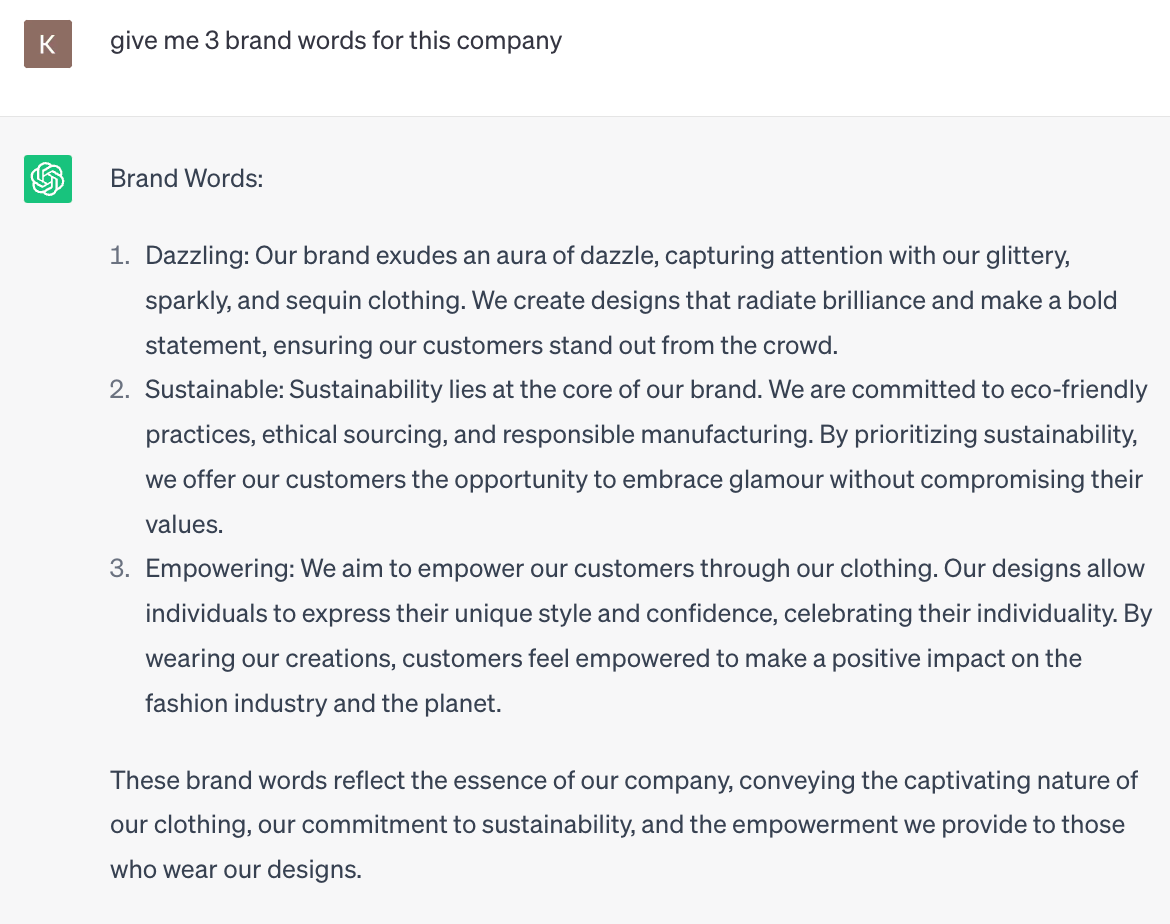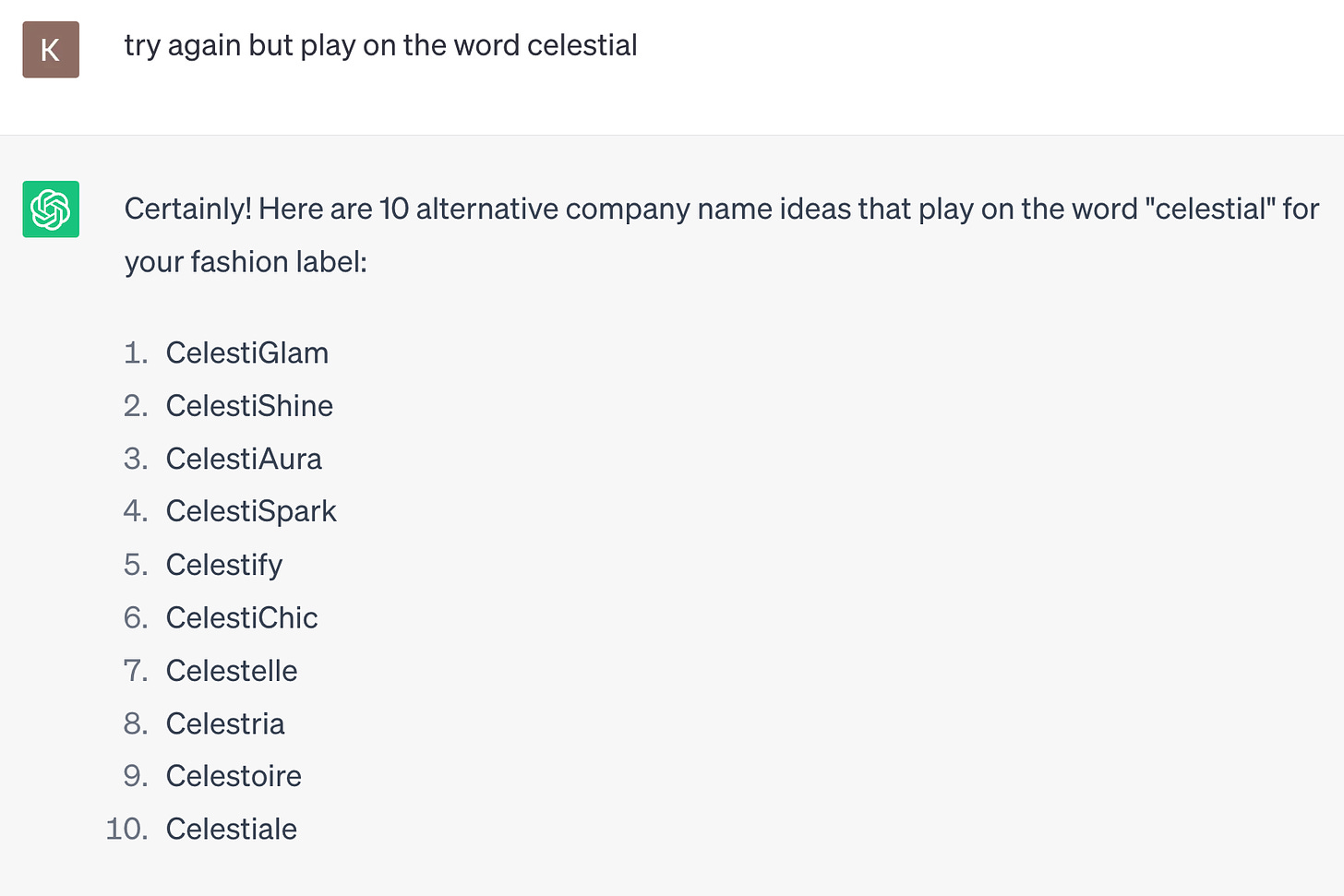If you’re strapped for time and resources, Chat GPT can be a useful starting point for creativity and innovation. I’m going to share prompts you can use to design a brand in less than an hour.
Firstly, why do you even need a brand?
If you’re looking to stand out in today’s market, you need a brand. It’s what gives your company personality and positions you uniquely among competitors. Without a brand, you’re bland.
Having a strong brand helps you build trust, loyalty and credibility. It’s the reason why your customers buy from you. According to a survey by Nielsen, 59% of consumers prefer to buy products from brands they are familiar with.
A strong brand presence increases familiarity and trust. You cultivate more desire to buy your products or your services. You make more sales. Your customers are happy. You retain more customers. You have a higher chance of unwavering customer loyalty. Nailing your brand is a no brainer.
Mini brand development process
I wanted to design a brand that sells sustainable alternatives to sequin, sparkly and glittery clothing. There aren’t many sustainable alternatives at the moment (learn more here). I wanted to see how far I could do this with the help of Chat GPT, so I took the idea through a mini brand development process.
Note: this is a reduction of the brand design process solely for the purposes of this experiment.
The prompts and process
For most steps, I found that Chat GPT sped up the process, but following its suggestions blindly would have led to a generic and uninspiring end result. Let me show you what I mean:
Defining a unique selling point
The prompt:I asked it for ideas on new science or technology I could use to make our clothing:
Human improvement:
While the above seems like it could be a good idea, Chat GPT isn’t able to apply those innovations and test it with your customers. If I was an e-commerce founder in this space, it’s an exciting time to be looking at creating something novel, but until you’ve put it in front of customers you don’t know how it’s going to land. For starters, I would want to know more about perception of existing examples.
On top of this, I would be reaching out to scientists, innovators, engineers to partner with and develop new fabrics or build with existing technology. Pangaia is a great example of a brand that’s already using smart fabrics. You can also take inspiration from PlatformE’s approach to digital personalisation too.Analysing competitors
The prompt:Human improvement:
Some of the competitors Chat GPT returned didn’t seem to have much of an established online presence - a few were only selling on Etsy not on their own website. It’s always worth remembering that it only takes data from pre-2021 so as it even advises, take the extra time to do your own research or hire someone to do this for you.
From a design and e-commerce perspective, it’s better to see visual references of your competitors’ products, brand and screenshots of their website. Some additional references I found here included Rotate, Self Portrait, and LaPointe. While they all had a range of the type of clothing I imagined this brand to have, that wasn’t there sole purpose, so it seems like this could be a good USP for this brand to sell only sparkly / sequin items.
Writing a mission statement
The prompt:Human improvement:
My personal experience of the answers Chat GPT gives is that it leans on the slightly cheesy side. To get around this, it always helps to provide it with some samples of your own writing or a paragraph of copy in a similar tone of voice that you want to emulate.
If you’re part of a wider team, when coming up with a mission statement for your brand, this is better done in collaborative workshops where you can co-create a mission that your team can all get behind for better results. Working with the team, you could edit the copy yourself with the team, refining what works and removing what doesn’t.
Or an even better approach would be defining some key parts of your mission with the team and then feeding that to Chat GPT as a more specific prompt, getting it to write a statement with more of your own input.Defining our target customer
The prompt:Human improvement:
Defining your target customer requires user research and speaking to them. Chat GPT uses existing data, but doesn’t have the capacity to talk to your target market. I would use use this as an assumption for who your target market could be, but then follow this up with actual research and get even more specific about where your customers are located and how to attract them, what other brands they shop with, what’s important to them, and what their shopping behaviours are like.
Based on this research, I might be able to narrow down to a target demographic, so here for example - perhaps I’d want to appeal more to Gen Z customers who want to express their individuality, or might be more likely to buy this type of clothing for nights out, festivals or standing out.Choosing brand words
The prompt:Human improvement:
These were pretty good, but as I mentioned previously, I do feel like some of the answers it gives can be cheesy. I didn’t particularly like the word ‘dazzling’. You can always adapt your prompt or ask Chat GPT to provide more ideas.
My recommendation here would be to always apply your own critical evaluation of what it suggests, work with your team on refining the ideas, and test with a sample of your target customers.Coming up with a brand name
The prompt:Human improvement:
Erm… yeah. For me, this is Chat GPT’s biggest limitation right now. It’s bad at creativity. I’m pretty confident if I put any of these in front of Gen Z, they would not pass the vibe check.
A few other prompts I tried like “give me 10 less cringey examples” and “try again but be more creative” returned even more disappointing results. When thinking about this brand, the word celestial was at the forefront of my mind, as in like the stars in the sky, feeling ethereal or ‘out of this world’. So I tried another prompt based on this:I disliked all the examples, but was inspired to chop all the suffixes it added and go with a simple ‘Celesti’. Another point to note is that Chat GPT is unable to provide legal advice on copyright or trademark infringement, so I’d advise seeking out a professional to support with this.
Designing a logo
The prompt:Human improvement:
Again, it lacks creativity. You need to critically evaluate its suggestions, build on generic ideas and come up with a brand logo that will stand out among a sea of competitors. You can provide more specific prompts like this to get more unique ideas:You can then combine a mix of these ideas and your own to create something less generic and boring.
Creating a colour palette
The prompt:
(I already had 2 colours in mind based on some existing competitor research I did so fed it those colours and asked for additional ones to supplement them)Human improvement:
Chat GPT can’t test for accessibility or see how these colours look in combination. This is where as a designer, I would be playing with the colours in a design tool to see how they look together and alongside brand imagery, and also testing for compliance with web accessibility standards using plugins like Contrast in Figma.Choosing typography
The prompt:Human improvement:
It suggested font pairings from Google Fonts, so you can try more specific prompts asking it to search sites like Creative Market or Adobe Fonts. I immediately dismissed it when the first idea it returned was this typeface for the brand:Nothing beats actually just looking for good typography as it’s such an integral part of creating the right vibe for your brand.
The final result:
While I used Chat GPT as a starting point, I made the final decisions around how to take those ideas forward. When designing a brand, being generic is commercial suicide. It’s also not a process you want to rush, if you want to stand out in today’s market, especially if your products are in a saturated market. Your brand and positioning can make or break you. Chat GPT however is a great tool for speeding that process up.
The verdict:
Don’t rely on AI tools if you want a brand that stands out. You’ll end up with something generic that doesn’t reflect your brand’s true personality.
If you’re using Chat GPT, don’t stop at the prompts it gives you, use your own critical analysis, research and human intuition to improve on what it returns. And remember that while it’s a great starting point it can’t do this yet:
Create and innovate like a human
Empathise like a human to understand your target audience
Look up recent data and trends in the same way you can
Understand your target audience
Develop a brand strategy and. maintain consistency
Help you with legal and ethical issues.
Get a designer or other professionals to support you with this.
More from Design For Good Club
Follow us on Instagram
Check out our services
Learn about our values
Watch us on Youtube


















